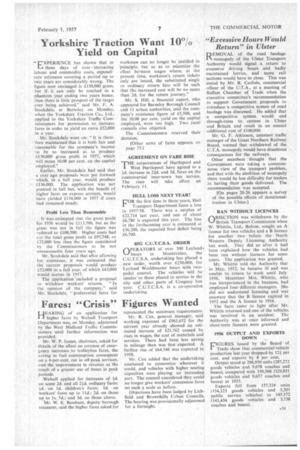"Excessive Hours Would Return" in Ulster
Page 33

If you've noticed an error in this article please click here to report it so we can fix it.
REMOVAL of the road haulage monopoly of the Ulster Transport Authority would signal a return to excessivedriving hours and badly maintained. lorries, and more rail sections would have to close. This was stated by Mr. R. Carlisle, commercial officer of the U.T.A., at a meeting of Belfast Chamber of Trade when the executive committee's recommendation to support Government proposals to introduce a competitive system of road haulage was discussed. Ile added that a competitive system would end through-rates to, centres in Ulster and Britain and result in an annual additional cost of £100,000.
Mr. G. F. Atkinson, assistant traffic manager of the Great Northern Railway Board, warned that withdrawal of the U.T.A. monopoly would have disastrous consequences for the railways.
Other members thought that the Government were taking a commonsense view, of the transport problem, and that with the abolition of monopoly there would be less difficulty for traders in having their goods delivered. The recommendation was accepted.
[On pages 20-24 appears a survey of the possible effects of denationalization in Ulsterl RAN WITHOUT LICENCES
Oi3JECTION was withdrawn by the British Transport Commission when W. Whittle, Ltd.. Bolton, sought an A licence for two vehicles and a B licence for another two before the North Western Deputy Licensing Authority last week. They did so after it had been explained how the vehicles had been run without licences for some years. The application was granted.
Mr. Whittle told the Authority that in May, 1952, he became ill and was unable to return to work until July 1956. Meantime Mrs. Whittle, who was inexperienced in the business, had employed four different managers. She did not understand licensing and was unaware that the B licence expired in 1952 and the A licence in 1954.
The facts came to light after Mr. Whittle returned and one of the vehicles was involved in an accident. The Authority was at once informed and short-term licences were granted.
1956 OUTPUT AND EXPORTS DOWN
FIGURES issued by the Board of Trade show that commercial-vehicle production last year dropped by 12+ per cent. and exports by 8 per cent.
Output stood at 296,950 units (287,272 goods vehicles and 9,678 coaches and buses), compared. with 339,508 (329,851 goods vehicles and 9,657 coaches and buses) in 1955.
Exports fell from 157.324 units (154,123 goods vehicles and 3,201 public service vehicles) to 145,172 (141,434 goods vehicles and 3,738 coaches and buses).




































































































